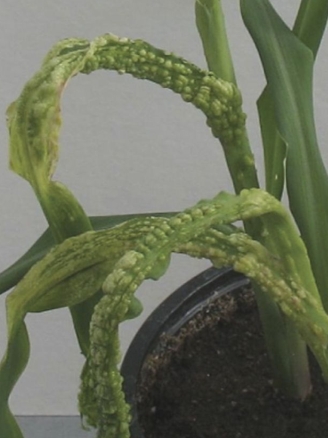Into the maize
Interview with
The pathogen that causes corn smut in maize employs a sophisticated strategy to increase its virulence. Regina Kahmann, from the Max Plank Institute in Marburg, Germany has solved a mystery in maize,
 which is vulnerable to infection by fungus called, Ustilago maydis. It triggers tumours to form in the plants, and bizarrely, it makes them produce the deep red pigment, anthocyanin and now, we know why.
which is vulnerable to infection by fungus called, Ustilago maydis. It triggers tumours to form in the plants, and bizarrely, it makes them produce the deep red pigment, anthocyanin and now, we know why.
Regine - The pathogen is very unusual. It infects maize, then the symptoms are huge tumours produced on all above-ground parts of the plant and it's in this tumour tissue that the fungus proliferates and produces spores. It's very severe. If you ever tried to grow sweet corn in your own garden, then it's very likely that you will get an infection.s tumours to form in the plants, and bizarrely, it makes them produce the deep red pigment, anthocyanin and now, we know why...
Chris - So how did you approach trying to study this pathogen to work out how it clearly does manage to bypass the defences in sweetcorn?
Regine - The idea here was to basically take the genes for all these unknown proteins that are predicted to be secreted and delete them. That is very easy in this system. And then ask, can this modified fungus still infect? And if the answer is yes, but not so well anymore, the question is to find out where it is arrested, how far does it get, and why does it not get any further? And why does it not get any further is then accompanied by trying to find out which plant protein does this fungus protein interact with.
Chris - You make it sound very simple. I suspect that this was molecular clockwork that took quite a lot of unpicking. What did you find when you began to delve into this?
Regine - Well here, it was relatively easy because it turned out that when we identified plant proteins interacting with this fungal protein, there was only one. And this was an enzyme, it was an enzyme that modifies other plant proteins of kinase. The amazing thing is that the fungus targets a specific region, of this kinase which normally serves for the degradation machinery to degrade this protein. And by this fungal protein, the kinase is stabilised and then it becomes active.
Chris - So what effect does bolting that kinase into the on position actually have on the plant cells?
Regine - Okay, so what we think is happening is that this stabilised kinase actually alters the activity of a regulatory protein and this regulatory protein will then stimulate the expression of about 8 genes, all involved in the biosynthesis of a red pigment which is called, anthocyanin.
Chris - This is the same stuff that makes beetroot go deep red, isn't it? Sort of an antioxidant molecule, isn't it?
Regine - Exactly.
Chris - So what is it doing that for then? Why would it want the plant to make heaps of anthocyanin?
Regine - Yeah, this was really the most intriguing question and the one that kept us busy for a very, very long time. If you want to make this anthocyanin, this red colour, you need precursors and interestingly, one of these precursor molecules is also a precursor for lignification for lignin biosynthesis. So, lignin is a very complex structure that is made by many plants to stabilise the cell wall.
Chris - It's woody stuff. I mean, to put a sort of simple word on it, it's wood isn't it?
Regine - Yeah, it's wood.
Chris - So let me guess then, where you're going to go with this. You're going to tell me that by depriving the lignification process of raw materials, because they're all being bypassed into making loads of anthocyanin, this is going to stop the plant from laying down wood which would normally block up various tubes and passages and sequester the fungus in one part of the plant, stop it spreading.
Regine - Exactly.
Chris - Wow! I got it right. I'll go to the top of the class. Is that what we think is going on?
Regine - Yeah, this is exactly what we think is going on and you can actually show two things. One is, specific ways to visualise the lignin and interestingly, when you make this red pigment, there is very little lignin you can see. And this also means that the fungus gets to a certain compartment, in this case the veins, where the plant transports nutrients, and it actually gets inside the veins and we believe that this allows the fungus to get nutrients. And if you don't have this protein, this effector, then this region is heavily lignified. And you don't find the fungus inside this tissue anymore, and we think it's starving basically.
- Previous Evolution at work in ants
- Next HIV Complex problem solved










Comments
Add a comment